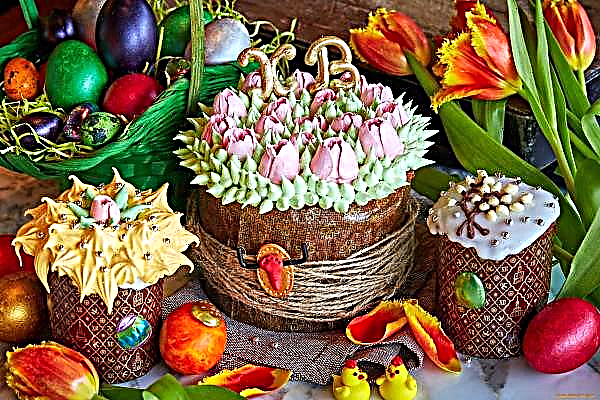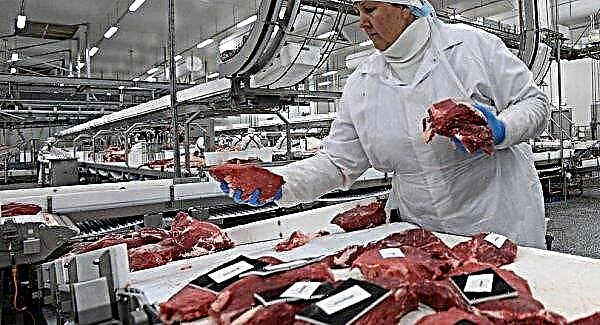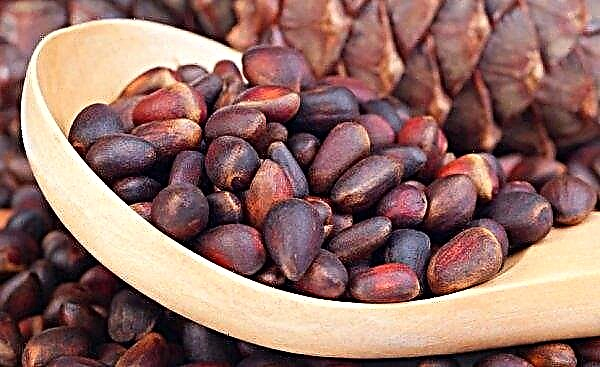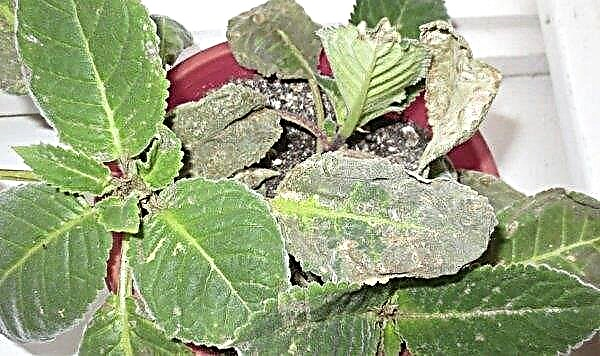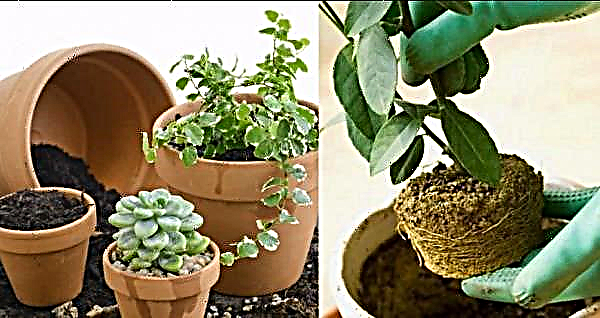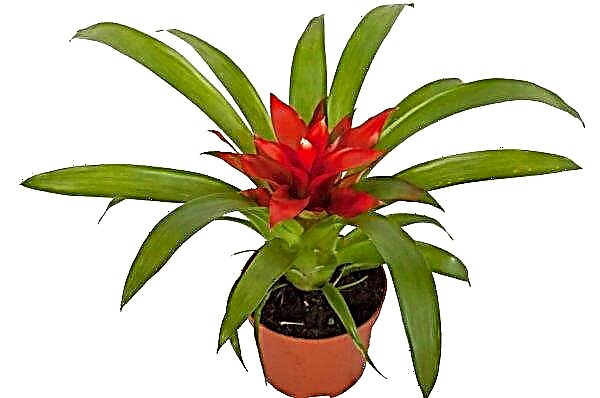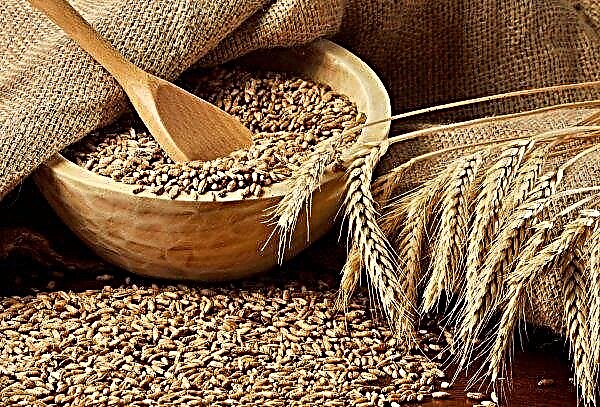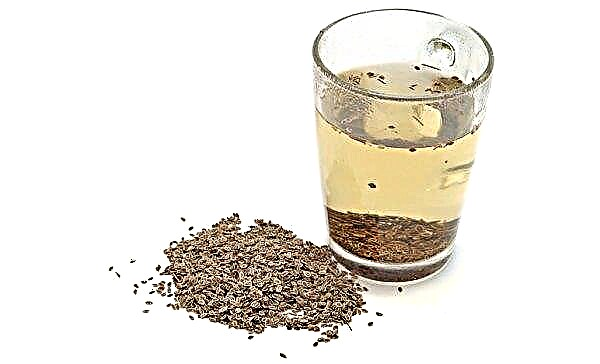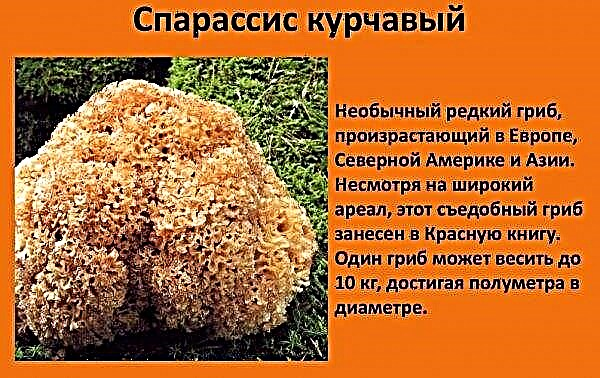Almost everyone loves apricots, but, unfortunately, few varieties of this tree are suitable for growing in temperate zones. However, there are still exceptions. These include with confidence the variety with the promising name Glory of the North, which will be discussed in this review.
Characterization and description of the variety
The glory of the North is a product of Soviet selection. The breeder Aleksey Nikolaevich Velyaminov, who even published a separate monograph on this subject in 1954, “Selection of Cherries, Plums, Apricots in the Middle Strip of the USSR,” was the inspiration for the cultivation of frost-resistant apricot varieties.
In addition to A.N. Velyaminov, L.A.Dolmatova worked on the creation of the Glory of the North, and the fruit-growing department of the Voronezh Agricultural Institute (now Voronezh State Agrarian University) named after Peter I became the base for breeding this tree.
Did you know? The Voronezh Agricultural Institute was opened in 1912 by personal decree of Nicholas II, becoming the second agricultural higher educational institution in the Russian Empire and the first university in Voronezh. The townspeople themselves asked the institute to give the name of Peter the Great, noting the close connection of the Tsar Reformer with the region, and in response to this petition, the last of the imperial Romanovs drafted the phrase "To this end."
Despite the obvious merits of the variety, the Glory of the North is not included in the State Register of Breeding Achievements of the Russian Federation, and there is no exact information regarding the genetic formula of this apricot.
Obviously, the variety arose as a result of free pollination of another frost-resistant apricot - Triumph Severny, which, in turn, was bred by Voronezh breeders by crossing the popular Severny early apricot in the Transbaikalia and the well-known Krasnoshchechka.
 As a result, preserving all the taste and other valuable characteristics of Krasnoshchek, it was possible to achieve a much higher resistance of the tree to cold weather - both winter and spring return
As a result, preserving all the taste and other valuable characteristics of Krasnoshchek, it was possible to achieve a much higher resistance of the tree to cold weather - both winter and spring return
Initially, the Glory of the North was oriented toward cultivation in the Voronezh, Kursk, Belgorod, Tambov and Lipetsk regions (Central Black Earth region of the Russian Federation), where the climate is characterized by severe changes in winter temperatures - from severe frosts to sudden thaws, as well as a high probability of spring back frosts. However, the variety very quickly gained popularity not only in the entire middle lane of the European part of Russia, but also in colder regions, including the Far East, the Urals and Siberia.
Today, the Glory of the North can be found everywhere in gardens and personal household farms of the Moscow Region, Kaluga and Kostroma, in Tver, Yaroslavl, Tula, Smolensk, Oryol, Ivanovo, Ryazan, Bryansk, Vladimir, Leningrad and other areas. In addition, the apricot fell in love with the inhabitants of the North Caucasus, Estonia and Latvia, as well as gardeners in the northern regions of Ukraine and Belarus.
The main characteristics of the Glory of the North:
| Wood | Tall, on average 3-4 m, but without regular pruning, can grow up to 5 m and above |
| Crown | Conical or spherical (depending on the formation method), slightly thickened, sprawling, strong and powerful skeletal branches |
| Leaves | Medium in size, light green in color (orange in autumn) |
| Flowers | Light pink, large, diameter reaches 30 mm |
| The arrangement of inflorescences | On special processes (spears) |
| Fruit shape | Oval |
| Fruit Sizes | Large, depending on the age of the tree, care and rationing of the crop, the weight of one apricot can range from 30–40 to 50–65 g |
| Skin | Not very dense, covered with fleecy, golden color with a blurred blush |
| Pulp | Orange, not very juicy, without difficulty moving away from the bone |
| Bone | Large, edible nucleolus, has a sweet taste with almond notes. |
Drought resistance, frost resistance
Justifying the name, the Glory of the North variety is distinguished by excellent winter hardiness. Wood tolerates winter frosts within -28 ... -30 ºС without visible losses. Resistance to frost in the fruit buds is less pronounced, and with sharp fluctuations in temperature in winter or during the period of spring return frosts, these parts of the plant often freeze.
Important! Despite the fact that the apricots taste the Glory of the North, in addition to a bright sweetness, there is a distinct sourness, the tasting score of these fruits is very high - 4.5 points on a five-point scale.
However, this feature does not interfere with the successful cultivation of the variety in regions with a cold and changeable climate, since the tree has the ability to quickly recover after freezing. Thus, according to the observations of the Voronezh breeders, the fruit buds of the Glory of the North froze for eight years in a row, but this has never prevented the tree from blooming profusely in due time and subsequently giving a stable crop.
 Other weather anomalies during flowering of the tree are much worse for apricot productivity. These include, first of all, heavy spring showers, harsh winds, as well as an atypical increase in air temperature (above 25 ° C), accompanied by severe drought
Other weather anomalies during flowering of the tree are much worse for apricot productivity. These include, first of all, heavy spring showers, harsh winds, as well as an atypical increase in air temperature (above 25 ° C), accompanied by severe drought
However, with the exception of this period, the Glory of the North variety is characterized by a rather high drought tolerance: even without regular watering during the dry summer, the tree is able to grow normally, however, in order for the fruits to set and form in full force, periodic irrigation of the apricot is still necessary, while to preserve moisture in the soil, the area of the trunk circle in regions with a hot climate is advised by experts to mulch.
Apricot Pollinators
The glory of the North has a high degree of autonomy and does not need pollinators on the site. Nevertheless, even self-pollinated apricots bear fruit much better if trees of the same species are planted next to them, coinciding with this variety in terms of flowering. In relation to the Glory of the North, such a role can best be fulfilled by:
- Triumph of the North;
- Champion of the North;
- Best Michurinsky;
- Amur.

Productivity and fruiting
The flowering of the Glory of the North usually begins in late April - early May. The first fruits reach technical ripeness by mid-July, and a full crop ripens after 15–20 days, in general, the fruiting period takes about three weeks. Such characteristics make it possible to classify the variety as medium-late.
Did you know? The average yield of apricots grown in favorable conditions is about 75 kg per tree, but with good care, some varieties provide up to 80-100 kg. A record for this type of fruit is considered to be 150-200 kg from one tree.
A distinctive characteristic of the Glory of the North is the early entry into the fruiting phase: the seedling begins to bloom two years after planting, and starting from the fourth year it gives the first crop. By the time the tree reaches the age of 5–6 years, truly abundant fruiting begins. During this period and for the next 20-30 years (with proper care and pruning), from 20 to 25 kg of fruits can be collected from one apricot.

Disease and pest resistance
According to the reviews of professional gardeners and gardeners with experience in growing the Glory of the North, this variety is highly resistant to most fungal diseases, with the exception, perhaps, of perforated spotting (klyasterosporiosis). Attacks of numerous pests usually do not do much harm to an adult tree.
Advantages and disadvantages of the variety
- Summing up the general description of the apricot Glory of the North, we can distinguish the following advantages of this variety:
- unpretentiousness;
- high frost resistance and ability to quickly recover in case of damage to wood and fruit buds by frost;
- drought tolerance;
- good immunity to pests and most diseases characteristic of apricot;
- self-fertility;
- early entry into the fruiting phase and a long period of its activity;
- high commodity characteristics of fruits - beautiful appearance, large sizes;
- good tasting qualities of apricots;
- universal purpose of the crop.
- However, the variety has the Glory of the North and some disadvantages. Among them should be called:
- poor resistance to clastosporiosis;
- late ripening;
- relatively low productivity;
- the tendency of wood to heat during thaws.
Planting and caring for apricot Glory of the North
Since apricot belongs to heat-loving crops that were not originally intended for cultivation in the middle lane, for good growth and fruiting in such regions, the tree needs to be created favorable conditions already in the process of planting.
Did you know? The true homeland of apricot is not clarified by scientists. There is a version that the tree originally grew in the mountains of the Tien Shan (China), however, perhaps the natural distribution range of the species was still Armenia, and the apricot came to Europe thanks to Alexander the Great or, more likely, to the ancient Romans during the period of military conflicts between the Empire and Parthia for supremacy in the Middle East.
Recommended Dates
Usually fruit trees are planted in early spring or late autumn, and the second option is considered by most gardeners as more preferable, since the tree in this case manages to strengthen by the beginning of the growing season and then easily copes with both the active growth of the aerial part and the attacks of pathogenic fungi and pests that sleep in the fall, and in the spring begin to multiply intensively.
Video: Planting and caring for apricot
However, residents of the middle zone of the European part of Russia and colder regions should plant spring for apricot planting, since a harsh local winter can be fatal for a fragile seedling.
With regard to specific calendar dates, they vary depending on climatic conditions. Sample recommendations on this subject are as follows:
| Region | Optimal time for landing |
| Rostov Region, Stavropol Territory, Dagestan, Ingushetia, North Ossetia, Chechen Republic | third decade of March - beginning of April |
| Moscow Region, Kostroma, Kaluga and other regions of the central part of the Russian Federation | first half of April |
| Leningrad region, Estonia, Latvia | mid april |
| Ural, Far East, Siberia | early May |
To determine the favorable moment, you need to consider that it will be easier for the seedling to take root if the planting is carried out before the buds of the tree wake up. Early spring is good because during this period the soil is still quite moist, and until the summer heat, which is a difficult period for any plant, there is still enough time for the seedling to grow the root system and get a little stronger.

Choosing the right place
For the apricot, it is best to choose an open and well-lit area, if possible, protected from the north by a fence, building or tall trees so that the cold winds do not harm the young seedling.
One of the most famous problems when growing apricots is the heating and peeling of wood after winter. The main reason for this phenomenon is not in severe frosts, as many people think, but because the lower part of the trunk has been in a puddle of melt water for a long time. In this state, the tree rots along the ring, and its upper part, having lost nutrients that cannot come to it from the root due to the affected trunk, gradually dies.
Important! The optimal place for apricot is not a flat ground, but a gentle, but not more than 10 ° slope, preferably south or southwest. Here, the sapling is not threatened by either northern winds or waterlogging of roots as a result of spring floods.
Trying to help the sapling to endure the winter, many gardeners try to wrap it as densely as possible with agrotechnical fiber, spruce spruce branches and other heaters, which ultimately only prevent the evaporation of moisture from the wood. In the spring, looking at the dead seedling, the gardener complains that the tree is frozen and next year doubles efforts to “protect” young apricots, while the problem could be solved much easier and more efficiently, simply planting a tree on a slope - natural or specially constructed for apricot.

Adverse neighbors and predecessors for apricot are solanaceous plants (potatoes, tomatoes, eggplant, sweet and bitter peppers), and strawberries. At the place where the tree is planned to be planted, such crops should not be grown for at least three years, otherwise the seedling will be sick.
The distance between the Glory of the North and other trees should ideally be 5-6 m, but in small areas where such space cannot be achieved, you can reduce this distance to 3-4 m. However, in the latter case, forming the pruning of the garden should be carried out in this way so that the crown of one tree does not interfere with development and does not obscure its neighbors.
Selection and preparation of planting material
For planting the Glory of the North, it is best to use seedlings aged from one to three years. When choosing planting material should be guided by two basic rules:
- buy a seedling should be in a specialized nursery, in this case, the risk of encountering a fake or low-quality goods is minimal;
- the nursery should be located as close as possible territorially to the final place of planting (regardless of the declared winter hardiness of the variety, it is easiest for the tree to take root and adapt to new conditions if they do not fundamentally differ from those in which the seedling was originally grown).

If these conditions are met, there is nothing to worry about, but still it will not hurt to give an external assessment to the tree. The main thing you need to pay attention to:
- plant height - no more than 1–1.5 m;
- absence of broken branches, cracks and other damages, uniform bark color;
- sleeping, but clearly visible buds (the presence of full leaves on the tree is rather a drawback, they will still need to be removed before planting);
- the presence of at least 2-3 lateral branches on the main root, with the length of each process not less than 20–25 cm, the roots should not be dried;
- the presence of vaccination.
Did you know? Interestingly, apricots were brought into the vast territory of the Russian Empire at different times and in different ways. Thus, Europeans introduced these fruits to the inhabitants of the central regions of the country in the 17th century, but heat-loving fruits came to the Crimea, the Caucasus and Ukraine much earlier and directly from their historical homeland - the Middle East, more precisely, Persia, as evidenced, among other things the old Ukrainian name for the fruit is “spade”, which has Iranian roots.
Before planting, it is useful to soak the seedling in water for 24 hours, dropping the tree in the liquid 1/3 of its growth. Then you should carefully examine the roots, slightly trim their tips to stimulate growth, and then dip the roots of the seedling in a mash made of clay, water and manure. After the clay dries slightly, you can begin to plant.

Direct landing
When growing apricots in areas with extremely cold climates, planting is best done not in the traditional way, but according to the method proposed by gardeners Zhelezov, Baikalov and Chuguev. The main distinguishing feature of the technology is that the tree should not be planted in a pit, but rather on a hill. This method avoids the risk of deepening of the root neck, which for apricots, especially in cold and humid weather, can become fatal.
Planting a seedling using the technology of Zhelezov, Baikalov and Chuguev is carried out as follows:
- Mix garden soil with rotted manure (or by no means fresh) manure or compost, and if the original soil composition is heavy, add sand or peat (the last component is acceptable for alkaline soil to increase its acidity, but if the soil has a neutral reaction, it is necessary save). Enrich the resulting mixture with humus and mineral fertilizers (for example, 200 g of superphosphate and 500 g of wood ash can be added to 8-9 buckets of substrate).
- To form a hill 1.5–2 m in diameter from the prepared nutrient mixture and compact its surface so that as a result the embankment is 0.5 m above the ground. Make sure that after this procedure at least 25 liters of soil mixture are left in stock.
- Measure the total length of the root system of the seedling and make a hole on the top of the hill with a depth of not more than 30% of the obtained value.
- Pour 10–20 L of well-maintained and well-warmed in the sun (or brought to room temperature) water into a hole.
- Set the seedling in the hole, directing it by grafting to the south, carefully spread the roots.
- While holding the tree in an upright position, fill the hole with prepared soil until its level reaches the root neck.
- To level and ramp the hillside again so that its slope does not exceed 45⁰.
- To ensure that over time the embankment does not level with the ground level, fix the slopes with annual or perennial grasses. For this purpose, you can use siderates or ordinary lawn grass with a low stem and a superficial, but strong root system. The birch moth is very good in soil retention; it is present in many lawn mixtures. After some time, a dense carpet of such grass will not only fix the slopes of the hill, but also provide excellent protection for the young tree: from weeds in the summer, and from freezing in the winter.

Aftercare for Apricot
Apricot Glory of the North refers to unpretentious varieties that require quite ordinary care, including quite standard measures - pruning, preventive treatment, watering, top dressing, soil care (weeding and loosening, or mulching).
Video: Planting and caring for apricot
Apricot crown formation. Glory of the North.
Immediately after planting an apricot, it is recommended that the central shoot of the tree be shortened by 30% and, in addition, remove all side branches growing at right angles. In the future, each year, in early spring, a continuation of the forming pruning is carried out, consisting in shortening the main skeletal branches and removing the vertical, damaged, as well as duplicating shoots.
Important! Apricots and peaches are very fond of pruning. The more often it is carried out, the larger the fruits are formed and the higher the overall productivity indicators.
The sparse-tiered or cupped form of pruning is best suited for the Glory of the North. The main task of the gardener is to transfer the bulk of the fruiting to the side branches. With a cup-shaped crown, 4–5 pieces are formed taking into account the central shoot, which does not stand out among others in height, and with a sparse-tier method, 5–6 pieces are looking in different directions and directed at the most obtuse angle to the trunk. So that the branches do not interfere with each other and are equally well lit, the distance between the tiers should be at least 40-50 cm.

After the main shape of the crown is formed, apricot pruning continues to be carried out annually, but not so dramatically. When yield indicators begin to decline, radical anti-aging pruning is carried out, after which the fruiting volumes are restored quite quickly.
Pest and Disease Control
Despite the high immunity, the Glory of the North can still suffer from various fungal, bacterial and other infections, in addition, the gardener may face the fact that the tree was attacked by harmful insects and ticks. It can be quite difficult to save a tree from such misfortunes, therefore, it is best to deal with them with preventive methods.
The first and main task of the gardener in this regard is strict adherence to agricultural technology and monitoring the sanitary condition of the site. In particular, the fallen fruits and leaves must be removed and burned in a timely manner, since it is in them that the main enemies of the tree winter.

For the same reasons, it is important to regularly weed in the area, and even better, plant an area of the trunk circle with green manure or plants that repel pests (for example, petunia or marigold).
In addition, in the spring, before the buds open and before flowering begins, the apricot must be treated with urea, iron or copper sulfate (Bordeaux mixture), or other drugs with a pronounced insecticidal, acaricidal and fungicidal effect.

Harvesting and storage
Any gardener knows that apricots are fruits with very short shelf life. Some experts are trying to solve this problem by taking fruits as they reach technical, not biological ripeness, that is, simply put, immature.
In this state, the apricots are really easy to transport and, moreover, can easily bathe at home on the windowsill, however, unlike plums, for which this kind of trick is really an excellent way out, they lose significantly in quality.
Important! Apricots that matured at home are always less sweet and fragrant than those fruits that were completely ripe from the tree.
In order to preserve apricots for 2-3 days, you need to be guided by the following rules:
- Harvesting should be carried out only in dry weather;
- never put fruits taken from a tree and picked up from the ground in one container (even if an apricot that fell to the ground during harvesting looks completely intact and intact, it will become the reason that literally in a few hours the entire contents of the container where the crop was stacked, turn into an unappetizing mess);
- Sort freshly picked fruits immediately, selecting soft and damaged fruits and packing them separately from others;
- put the apricots remaining after culling in boxes or cardboard boxes lined with paper towels in one layer, and it is very desirable that the fruits, so far as possible, do not touch each other.
 But even with all these precautions, apricots need to be used as quickly as possible.
But even with all these precautions, apricots need to be used as quickly as possible.
If it comes to processing, it should be done on the day of collection, for fresh consumption, fruits can last 2-3 days, but they must be sorted as often as possible, constantly removing those copies that become too soft.
Harvest of the Glory of the North has a universal purpose, and therefore, any direction of use is suitable for its fruits. Those apricots that could not be eaten fresh can be used to make jam, compotes or toppings for baking, soft and slightly damaged fruits will make excellent jam, and carrion will make great home-made wine and stronger drinks.
Important! Apricots are not suitable for freezing, because during defrosting they completely lose their structure, however, the excess crop can be dried.
When using the harvest of the Glory of the North, do not forget about the seeds. Their kernels have excellent taste and can be used both fresh and for stuffing whole fruits and making first-class jam.

Apricot Glory of the North is an excellent choice for those summer residents who are not ready to devote too much time to their garden. This variety is difficult to attribute to the elite, but it is unpretentious, frost-resistant, able to withstand sudden cold snap and drought, has a high immunity to diseases and excellent fruiting. The fruits of the variety are distinguished by their excellent sweet taste with a pleasant acidity, due to which they can be consumed both fresh and used for preparing various homemade blanks.

